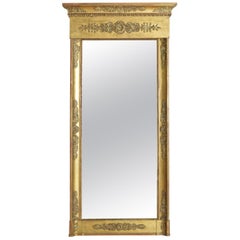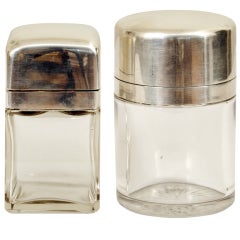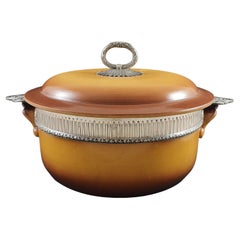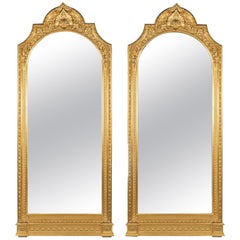ROBUCK
Color: Beige
French Empire Tall Carved Gitwood and Gilt-Gesso Mirror
Located in Atlanta, GA
Having a flat bottom and sides and top with convex form, the surfaces all decorated with gilt-gesso decorations consisting of friezes of foliate scrolls, neoclassical rosettes, and e...
Category
Antique 1810s French Empire Pier Mirrors and Console Mirrors
Materials
Gesso
Pair of 19th Century French Glass and Sterling Silver Vanity Receptacles
Located in Atlanta, GA
Each having a hinged top above a glass container complete with glass stopper, silver marks.
Cylinder measurements: Height: 4 in., diameter: 2.5 in,
cube measurements: Height: 3.7...
Category
Antique 19th Century French Neoclassical Sterling Silver
Materials
Silver
Related Items
19th French Terracotta and Sterling Silver Vegetable Dish
Located in Saint-Ouen, FR
Terracotta and Sterling Silver vegetable
Decorated with a frieze of pearls, foliage and foliage
Hallmarked Minerva 1st title for 950...
Category
Antique 1880s French Sterling Silver
Materials
Sterling Silver
Pair of Large Carved Giltwood and Gesso Mirrors
Located in Brighton, West Sussex
A fine pair of large carved giltwood and Gesso mirrors.
Each mirror has an arched mirror plate framed by foliate carved borders.
Possibly Italian or Austrian, circa 1870.
Category
Antique 19th Century Italian Wall Mirrors
Materials
Giltwood
19th Century Gorham Art Nouveau Sterling Silver Vanity Set, 7 Pieces
By Gorham
Located in Vero Beach, FL
19th century Gorham Art Nouveau sterling silver Vanity set, 7 pieces.
This stunning Art Nouveau sterling silver set is imaginatively created by Gorham. Each piece, as part of the matching set, abounds in glorious Art Nouveau embossed features including putti and foliate scrolls among numerous strewn floral embellishments. The set consists of seven fine pieces, all “sterling” serial numbered pieces are marked with the Gorham hallmarks. This English dresser set is comprised of a large hand mirror...
Category
Antique 19th Century English Art Nouveau Vanities
Materials
Sterling Silver
19th century Sterling silver fruit bowl
By Fenton Brothers
Located in Chelmsford, GB
A superb sterling silver fruit bowl ,
It is a very decorative piece of silver with swag and ribbon decoration that really does catch the eye. The thick gauge of silver used gives it...
Category
Antique Early 1900s English Rococo Sterling Silver
Materials
Silver
19th Century French Sterling Silver Fish Servers Set of Two Pieces
By Noel & Durand
Located in Sofia, BG
19th century French sterling silver fish servers set of two pieces i original box.
Noel & Durand, Bijouterie or Fevrerie, Montpellier, France, circa 1...
Category
Antique Late 19th Century French Sterling Silver
Materials
Silver
French Gilt Carved Wood Floral and Cherub Wall Mirror. Circa 1790
Located in Hollywood, SC
French gilt carved wood wall mirror with centered crest medallion, flanking cherubs perched on acanthus carved plinths, surrounded by molded edge with rope, floral, and beaded moti...
Category
Antique 18th Century and Earlier French Wall Mirrors
19th Century Italian Sterling Silver Madonna, circa 1830
Located in Milano, IT
Embossed and engraved silver plaque
La Madonna del lago (The Madonna of the Lake)
Probably Milan, post 1824
Brass frame
It measures 16.14 in x 13.85 in (41 x 35.2 cm) and it weighs 10.357 pounds (4.698 g): silver 1.31 pounds (598 g) + brass 9.03 pounds (4.100 g)
State of conservation: some abrasions on the bottom. The frame is old, but not original.
The plaque is made up of a sheet of embossed and engraved silver, and held in a solid brass frame. It depicts the “Madonna del lago” – “Madonna of the Lake” - (the Madonna with Child and San Giovannino) by Marco d'Oggiono (Oggiono, 1474 circa - Milan, 1524 circa), while changing only the background landscape. Almost certainly the subject reproduced in the plaque was taken from a famous engraving by Giuseppe Longhi (Monza, 1766 - Milan, 1831), one of the greatest engravers of his era.
The silver is unmarked, probably because originally the Madonna was due to be exposed in a church: sometimes precious metals destined for worship and liturgical use would be exempted from payment and were, therefore, not marked.
It is very likely that the plaque was made in Milan because in this city in 1824 the engraving by Giuseppe Longhi was made and printed. In addition, in Milan, the alleged lost painting by Leonardo da Vinci in his Milanese period (1482-1500) would be produced; this is the painting from which Marco d'Oggiono took his version.
The painting
Marco d?Oggiono was one of Leonardo da Vinci's most brilliant students and collaborators (D. Sedini, Marco d’Oggiono, tradizione e rinnovamento in Lombardia tra Quattrocento e Cinquecento, Roma 1989, pp. 151-153, n. 56; p. 225, n. 124, with previous bibliography). His style reflects in every way that of the Tuscan Maestro, so much so that he was the one who executed some copies of da Vinci's paintings. The execution of the “Madonna del Lago” probably draws inspiration from a lost painting by the Maestro, created while he was living in Milan (1482-1500). There are many similarities with other works by Leonardo such as the “Vergine delle rocce” or the “Vergine con il Bambino e San Giovannino, Sant’Anna e l’Agnello”.
The painting, from which the drawing and then the famous engraving were taken, is found today at the M&G Museum of Bob Jones University in Greenville, South Carolina, where it came to rest after the sale of the Harrington Collection in London in 1917.
The work appears in the inventories of the collection of Napoleon and Joséphine Bonaparte at the castle of Malmaison, before 1809.
The Malmaison building was born and developed in the 17th and 18th centuries. In the 18th century it belonged to Jacques-Jean Le Coulteux du Molay, a wealthy banker. Later, during the Directory, Joséphine Bonaparte de Beauharnais bought it on April 21st, 1799, but settled at the castle definitively only after her husband separated from her in 1809. She remained there until 1814, the year of her death. When Joséphine died, the estate passed to her son Eugène de Beauharnais, who moved to Munich with his whole family in 1815, bringing with him the collection of paintings he inherited from his mother. Eugène died in 1824 and his wife Augusta of Bavaria (von Bayern), unable to keep it, in 1828 sold the Malmaison to the Swedish banker Jonas-Philip Hagerman.
It is likely that in this period Augusta also sold part of the paintings inherited from her husband, including the “Madonna del Lago”. This painting then came into the possession of Leicester Stanhope, fifth Earl of Harrington (1784 - 1862) and then was passed down to his descendants.
In 1917, at the death of Charles, eighth Earl of Harrington, his brother Dudley inherited the title and properties and he put up a part of his collections for sale. Among these, precisely, the painting by Marco d'Oggiono was to be found.
On the occasion of that auction the painting was presented as a work by Cesare da Sesto, by virtue of a handwritten note by the Countess of Harrington on the back of the table. However, already in 1857, the German critic Gustav Waagen had identified Marco d'Oggiono as the author of the painting, then exhibited in the dining room of Harrington House in London (Treasures of Art in Great Britain, in 4 volumes, London, 1854 and 1857).
The engraving
Giuseppe Longhi was one of the most renowned engravers in Italy between the end of the 18th century and the first quarter of the 19th century.
In 1824 Giuseppe Longhi, based on a design by Paolo Caronni, made a famous engraving of the painting of Marco d?Oggiono. The activity of Longhi was then at the peak of his notoriety, enough to earn him very substantial commissions; it is not risky to suppose that some of his successful engravings were also reproduced using other means: in our case in silver. (A. Crespi, a cura di, Giuseppe Longhi 1766–1831 e Raffaello Morghen...
Category
Antique 1820s Italian Neoclassical Sterling Silver
Materials
Sterling Silver, Brass
French Gilt Carved Wood and Gesso Floral Wall Mirror, Circa 1820
Located in Hollywood, SC
French gilt carved wood and gesso wall mirror with a rope motif border, flanking floral corners, interior molded edge, and resting on molded rectangular plinths, Early 19th century.
Category
Antique 1820s French Louis Philippe Wall Mirrors
Materials
Gold Leaf
Gilt Gesso Pier Mirror in the manner of George I
Located in Sturminster Marshall, Dorset
A George I style carved giltwood and gesso looking glass mirror. The rectangular mirror plate is in a leaf and shell carved moulded frame beneath a shaped cresting centered by a pier...
Category
21st Century and Contemporary English George I Pier Mirrors and Console ...
Materials
Gold Leaf
Late 19th Century, French, Sterling Silver and Mother-of-Pearl Fish Cutlery
Located in LEGNY, FR
Beautiful 19th century French Sterling silver and mother-of-pearl fish cutlery, service for 8 people.
8 Forks and 8 knives. French punch (minerve) and Stamp R&C of the silversmith....
Category
Antique 1890s French Sterling Silver
Materials
Silver, Sterling Silver
H 7.49 in W 1.19 in D 0.79 in
A French Antique Beautifully Carved & Gilt Mirror, Standing over 5.5 Ft Tall
Located in Atlanta, GA
A tall French richly carved and gilt mirror from the early 20th century. This large-sized gilded wood mirror features a crest elaborately adorn with a bow-tie, ribbons, arrows and t...
Category
20th Century French Wall Mirrors
Materials
Wood
H 70.5 in W 45.5 in D 4.5 in
Russian Gilt Carved Wood and Gesso Arched Cornice Lapis Wall Mirror, Circa 1780
Located in Hollywood, SC
Russian gilt carved wood and gesso wall mirror with an arched painted lapis cornice, flanking fluted acanthus columns, and decorated with lambs tongue, bell flower, interior bead wor...
Category
Antique 1780s Russian Regency Wall Mirrors
Materials
Gesso, Mirror, Wood, Giltwood
H 55.5 in W 35 in D 4 in



